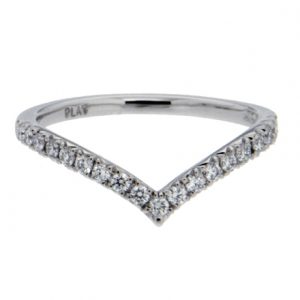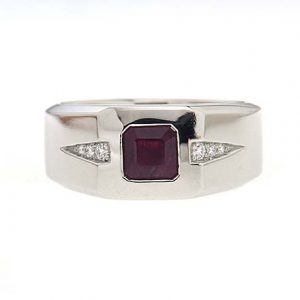Getting married is a landmark event in a person’s life, uniting them with a loved one with a bond recognized by one another, the state and society. For thousands of years, married couples have worn rings on the fourth finger of their left hands as a sign of their union. While the tradition of wearing wedding bands has endured, the styles, materials used and other matters have changed with time and place.
Depending on the culture and tastes of the couple, only one person, usually a bride, might wear a diamond wedding band. In places like the United States, dual rings are gaining in popularity. They may trade their engagement rings for wedding bands upon marriage, wear both rings on top of the other, get coordinating rings, or those that suit the individual wearer. Today, nearly anything goes.
Among the wedding band styles popular with today’s couples are simple metal bands, fancy shanks, diamond wedding bands, colored stones, diamond eternity bands, and others. It’s also common for women and men to wear different types of wedding bands, with women’s rings more likely to feature diamonds and ornate designs, and men’s wedding bands to sport subtle embellishment. The wealth of styles available means that there’s something to satisfy everyone.
Plain
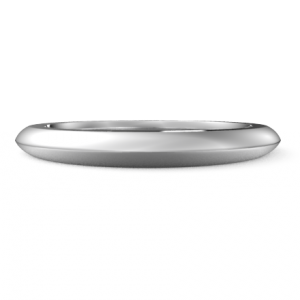
Plain wedding bands are far from dull. Not only is there a choice of precious metals to choose from, such as platinum, silver or colored gold, there are a variety of shapes as well. Wave wedding bands have a groove that runs across the entire ring, while dome wedding bands have rounded edges. Crisscross wedding bands resemble two shanks joined to form an X, and engraved gold wedding bands feature raised designs.
To find these designs and others, please visit our Wedding Bands Collection
Diamonds
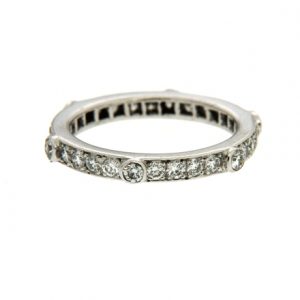
As with engagement rings, diamonds on wedding bands are a sign of love, the jewel’s hardness symbolizing the power of the bond between two people. Diamond wedding bands are also appealing on an aesthetic level, adding brilliance to the hand. On a practical level, the durability of diamonds allows them to withstand the rigors of daily life on a finger.
Aside from ensuring that your diamonds are securely mounted, there are no hard and fast rules for diamond wedding bands. The taste of the wearer is what matters. There are many styles to choose from, including diamond wedding bands for women, men’s weddings bands with diamonds, pave wedding bands, channel set diamonds, diamonds interspersed with colored gemstones and more.
Wedding Sets
It’s not uncommon for people to buy diamond wedding bands at the same time they do their diamond engagement rings. Couples may also purchase or design wedding and engagement rings that coordinate with one another, or coordinating rings for the fiancés. To fulfill these interests, designers may create wedding sets of two or more rings with complimentary precious metal, gemstones and embellishment.
A common variation on wedding sets are engagement and wedding bands sold as a pair. They can be further subdivided into two categories, those that appear to be two separate rings, and those that look like a single ring split in two. Some prefer the former, feeling that the rings are aesthetically appealing worn together or apart. Others like the symbolism of the latter, of two halves uniting to become a whole.
An inversion of a wedding set is a gimmal ring. They were popular during the Baroque era, particularly among engaged couples. Gimmal rings were often made of sets of two, with the bands designed to interlock with one another. During the engagement period, each fiancé would wear one half. During the wedding ceremony, the rings would be joined as one. Modern couples looking for unique engagement rings or wedding bands may want to consider something similar.
Wedding Bands for Women
Jewelry for women is often more elaborate and fanciful then men’s jewelry. Wedding bands are no exception. They’re more likely to be set with diamonds, have embellished shanks, and otherwise be designed to catch the eye. Three stone, eternity, solitaire and other popular styles are more likely to be worn by women. At the same time, women who prefer simple, low key styles can easily find diamond wedding bands that appeal to them.
Tradition influences a lot of the aesthetics associated with women’s wedding bands. Diamonds are the flashiest instance of wedding ring traditions, particularly as more diamond mines were discovered throughout the centuries. On the other side, diamond wedding bands for women are also impacted by trends, such as when a celebrity marries and their rings are photographed. It is up to each woman to find her ideal balance between tradition, what’s fashionable and her own tastes to find the ring that works for her. A few popular diamond wedding band styles are described below.
Three Stone Rings
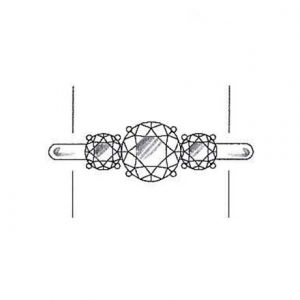
Three stone rings, also known as trinity or trilogy rings, feature a row of three gemstones on the band. The three jewels used are almost always diamonds, symbolizing an everlasting love. The design of three stones together is said to represent the past, present and future of a couple, making it a romantic choice of diamond wedding band.
Aside from having three jewels in a row, there are many variations to three stone diamond bands. Most often, three gemstone rings have side stones of the same size flanking a larger central jewel. The gemstones are usually of a uniform cut, such as three round brilliant diamonds in a row. A common variation is to have the central jewel of a different cut from the side stones, such as triangular diamonds around a princess cut.
There is no fixed way to mount or embellish a three stone ring. Many settings that are suited for holding a single stone in place, such as prong, bezel, coronet or trellis, are also good for holding three stone diamond wedding bands. Mounts such as bead or pave settings, which are designed for tiny accent jewels, may be less compatible with three stone diamond bands.
Design your perfect Engagement Ring
Solitaire Rings
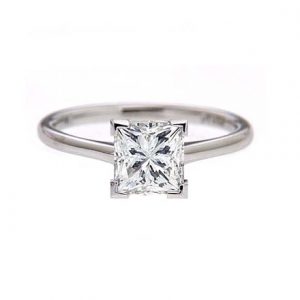
Solitaire rings get their name from the one jewel, usually a diamond, mounted on the band. While rings decorated with a single diamond date as far back as the Roman empire, solitaire rings as we know them today debuted in 1886 and has remained popular ever since. Solitaire diamond wedding bands are a good choice for those who want a timeless style, especially for a ring meant to be worn for a long time to come.
The minimalist design of classic solitaire wedding bands allows for plenty of light to enter the diamond. Round brilliant diamonds have been and still are a popular choice for solitaire rings due to its ability to take in and reflect light. Other brilliant and mixed cuts such as the radiant or the princess cut also do well with this style of diamond wedding band, for similar reasons. Cuts better known for their clarity, such as emeralds and Asschers may also benefit from the amount of light solitaire wedding bands allow, highlighting the interior of the stone.
There are many ways to add a special touch to solitaire wedding bands. Traditional settings for solitaires include four or six prong mounts. They hold the stone in place while allowing light to enter the jewel, bringing out its beauty. Styles such as the bezel, half bezel and flush mounts surround the stone, protecting girdles and points from chipping. Designs like trellis or cathedral mounts add visual interest to the sides of diamond wedding bands, and tension settings make a diamond appear as if it’s floating between the precious metal. All of these settings and more may be used to help customize a solitaire ring.
While solitaire wedding bands feature a single diamond, they may be as plain or decorative as the wearer desires. Designs include how the ring is polished, be it with a textured brush or hammer finish, a mirror-like bright finish, or a polish that gives a satiny luster. Engraving or embossing designs along the band is also popular. The more sentimental wearer may wish to have the name of their beloved, their wedding date or other meaningful words engraved onto their diamond bands.
Eternity rings
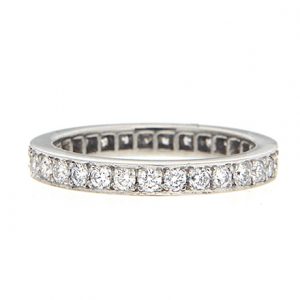
One of the more popular types of wedding bands are eternity diamond bands. They consist of diamonds of the same carat and cut that encircle the band entirely, giving the ring its name. Eternity diamond bands were first introduced in the 1960s by De Beers, who promoted the romance of many small jewels encircling the ring as a sign of an enduring love.
Due to the extreme circumstances in which diamonds are formed, the larger the jewel, the rarer it is. With all other factors equal, a one carat diamond will command a higher price than four 0.25 carat diamonds. Jewelry such as diamond eternity bands that are encrusted with many smaller diamonds create an appearance of abundance while being more budget conscious than larger jewels.
In the following decades, eternity wedding bands have taken on many looks. While many enjoy the appearance of diamond eternity bands, some find “half eternity” bands, those with one side of the ring encrusted in diamonds and the other side plain, more comfortable to wear. Other connoisseurs prefer the aesthetics of round brilliant diamonds, while others enjoy the look of oval or princess cuts. Some prefer the aesthetics of diamonds sharing common prongs, set in channels, or diamond bands covered in micropave. The possibilities are vast.
Wedding Rings for Men
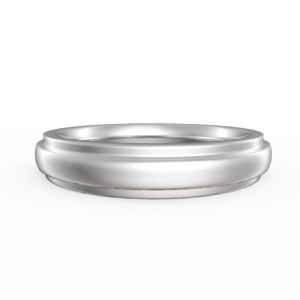
Men’s wedding bands are often much subtler in design than their female counterparts. At a glance, men’s wedding bands may appear to be the same plain design, over and over again. In practice, men’s wedding bands are an innovator of low key style. In truth, men’s wedding ring styles are limited only by imagination.
When a person thinks of men’s wedding bands, the first things that may come to mind are simple rings made of silvery or golden precious metal. Advanced alloys such as tungsten carbide may also capture the imagination, as might avant-garde seeming materials like blackened gold. When gemstones appear, they’re often small diamonds in bezel or pave style settings.
Plain
What first appears to be a simple circle of metal may have a wealth of design choices upon closer look. Aside from making sure the band fits, there are no fixed rules for what goes into making men’s wedding bands. For example, some of the more obvious on a glance design choices include the selection of metal and the width of the band. The wearer may prefer a cool based precious metal like platinum or white gold wedding bands, or enjoys a warmer hue like yellow gold. They may like a discrete width of a few millimeters, or wish to make more of a statement with wider wedding bands.
Subtler choices include how the ring is shaped. One can choose between a rounded domed band, a geometric flat or step edged band, or one grooves. Of the latter, one may select a ring with a channel that runs along the width of the ring, along the edges, or in a rounded or starkly edged form. Wedding bands may be further embellished with mille grains patterns, engraving, or romantic symbols such as clasped hands.
Mixed Metal
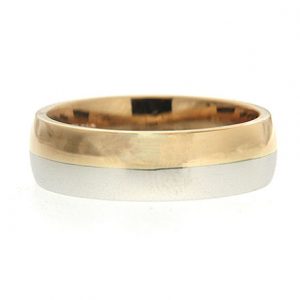
Some men’s wedding bands take a colorful approach. This might take a monochromatic form, like a rose gold band. Sometimes designers choose to use multiple form of precious metal in a ring to add visual interest. Two toned rings are a common variation, as are tricolored bands. Tricolor gold wedding bands may resemble three separate bands united as one, or as a striped ring. They may also resemble three interlocking rings, or have one dominant color, the other hues serving as accents.
With two toned gold wedding bands, some designs may use metal with a cool based hue, such as platinum, as the dominant color, then add a warm metal like rose or yellow gold as edging. Other styles may use the secondary metal as an inlay or a means of adding texture to the design. Still more variations may look monochromatic on the outside, its second color on the inner part of the band for the wearer alone to enjoy.
Uncommon Metals
It’s not uncommon for husbands-to-be, to want wedding bands as unique as they are. Others may be concerned about the durability of their ring, wanting peace of mind against dents and other accidental damage. One way to help their rings stand out from others is to choose a less traditional metal such as green or blackened gold wedding bands. These and other alloyed precious metals are designed to withstand the rigors of daily life.
In their pure forms, platinum, gold and silver are difficult to shape and is too soft to wear as wedding bands. When they are melted down and blended with other metals, a process known as alloying, the precious metals gain strength and durability. Even a piece meant to be worn constantly on an active part of the body is reasonably safe from harm.
Blackened metal stands out in sharp contrast to silvery or warm hued gold wedding bands. For the person who wants to make a statement with their wedding band, this makes a dramatic choice. The metals used to make these wedding bands aren’t naturally black. Materials such as gold may be alloyed with other metals to achieve the dark color. Another method is to treat the surface of the ring to achieve the desired color.
Finishes
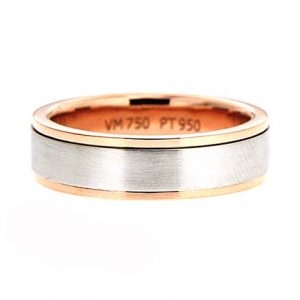
There are different ways to polish or otherwise play with the surface of a ring in order to give it visual interest. As many men’s wedding bands favor subtle design, how they are finished is an important source of embellishment. When it comes to men’s wedding bands, finish often refers to how it’s polished, though may be as varied as engine turning, engraving, repousse, or oxidizing.
Depending on the tools used, finished wedding bands may have different sheens. A bright finish creates a smooth surface with a mirror like shine. Gold wedding bands with bloom finishes will have a soft matte appearance with a thin layer of 24K gold. Brush finishes use wire brushes to create a series of just visible, parallel lines on a band, and satin finishes use brushes or sand to create a gentle gleam.
Other finishes take a more varied approach to texture. Antique finishes and other patina applications add color to wedding bands through coating. Stamping uses tools to impress designs onto the metal. Hammer finishes are especially popular, turning the exterior of the band into a series of tiny flat edges.
Gemstones
While many men’s wedding bands are made with only precious metal, there’s nothing stopping today’s groom from choosing a ring with gemstones. As with women’s wedding bands, diamonds are a popular choice of jewel, due to the romance of the stone and its long association with engagements and weddings. Colored gemstones may also make an appearance, usually as an accent to diamonds.
When diamonds appear on men’s wedding bands, they’re usually of modest size, often measuring less than a quarter of a carat. While the smallest of these diamonds are usually one of many, even the jewels on solitaire diamond bands are tiny. The overall aesthetic often uses diamonds as an accent to the precious metal rather than the other way around. The wedding bands they are set in tend to be visibly wider than the diamond.
Most of the diamonds on men’s diamond wedding bands are brilliant cut. Though styles like the princess cut may appear, the majority of the diamonds are round. Mountings tend to be bezel or other settings where the diamond is flush with the shank’s surface. A common alternative is the channel set, and a few examples feature prong mounts.
Other gemstones that find their way onto men’s wedding bands help add contrast against the diamond and the band. Like diamonds, the colored gemstones tend to be small, and placed into the band through flush or channel settings. They are also lightly used to decorate the band, similar to diamonds. There doesn’t seem to be a hard and fast rule for which colored gemstones to use in wedding bands, though facet quality stones are preferred.
Finding the right finger size
If you do not know the ring size for the ring you’re looking to purchase, you can use our Ring size guide, to help you determine the correct finger size. You can also use our ring width reference chart to determine how wide a wedding band would be on a finger. You can also request a free ring sizer, and we’ll mail it to you.
Request a free ring sizer | Ring size guide | Ring Width Reference Chart





